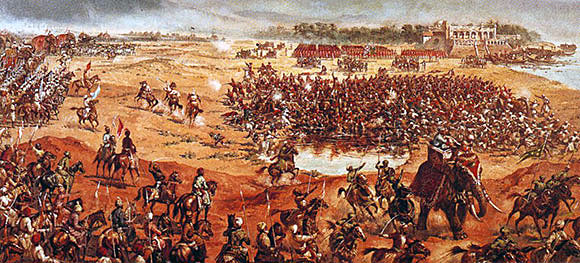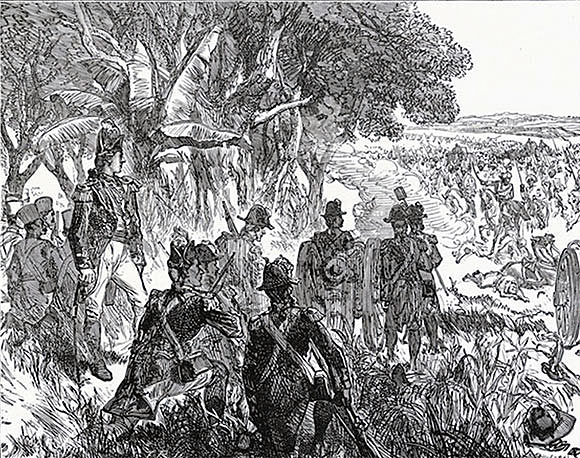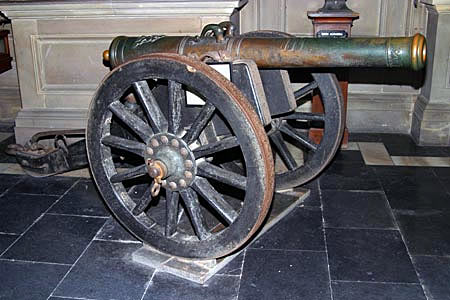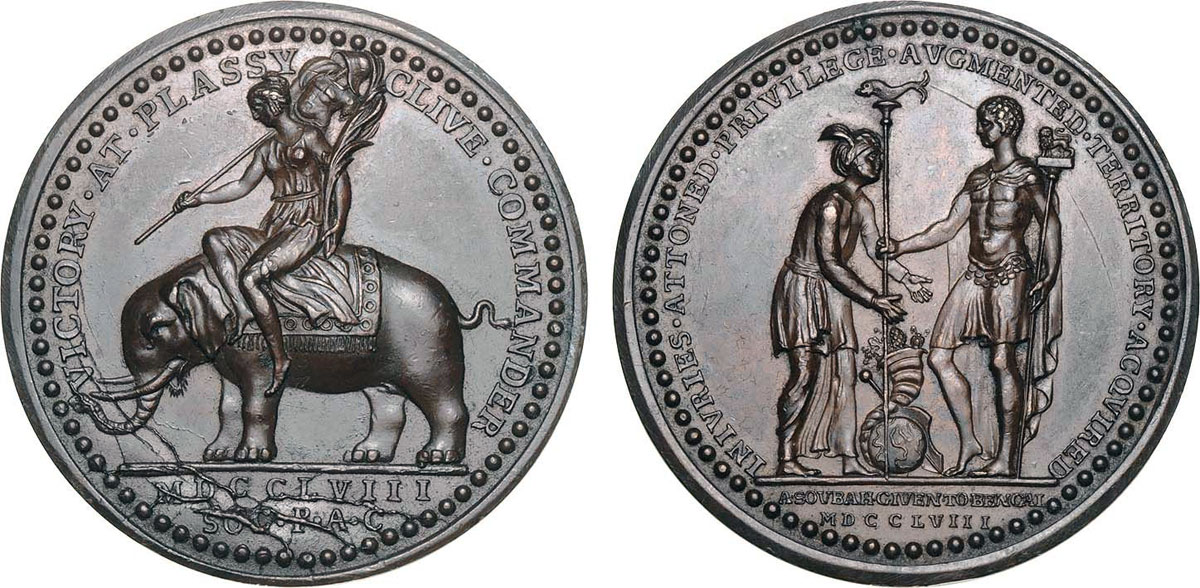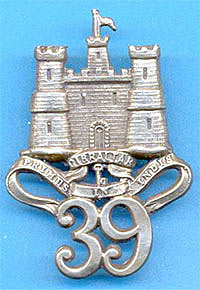The Keystone Battle for the British in India, fought on 23rd June 1757 and won with Treachery and Tarpaulins
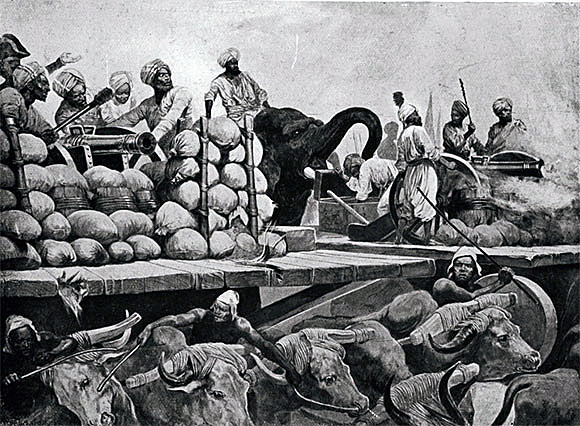
Siraj-ud-Daulah’s guns on wooden trucks pulled by oxen and pushed by elephants at the Battle of Plassey on 23rd June 1757 in the Anglo-French Wars in India: picture by Richard Caton Woodville
The previous battle in the Anglo-French Wars in India is the Battle of Kaveripauk
The next battle in the British Battles series is Braddock on the Monongahela
To the Anglo-French War in India index
Battle: Plassey
War: Anglo-French Wars in India (The Third Carnatic War)
Date of the Battle of Plassey: 23rd June 1757
Place of the Battle of Plassey: In Bengal on the Bhagirathi River to the north of Calcutta.
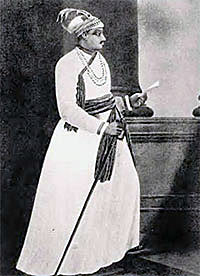
Siraj ud Daulah Nawab of Bengal: Battle of Plassey on 23rd June 1757 in the Anglo-French Wars in India
Combatants at the Battle of Plassey: The British East India Company against Siraj-ud-Daulah, the Nawab of Bengal, Bihar and Orissa and a small French force. The British were assisted by traitors in the Nawab’s high command.
Generals at the Battle of Plassey: Colonel Robert Clive against Siraj-ud-Daulah, the Nawab of Bengal.
Size of the armies at the Battle of Plassey:
Clive’s army at Plassey comprised 950 European Troops (including 250 men of His Majesty’s 39th Foot), 2,100 Indian troops being sepoys and topazes, 60 sailors and 100 artillerymen, with eight 6 pounder guns and two howitzers.
Siraj-ud-Daulah’s army comprised 35,000 infantry, 15,000 cavalry and 53 pieces of cannon, being 18, 24 and 32 pounders. A small French force commanded by St Frais provided supervision for the artillery and manned some guns.
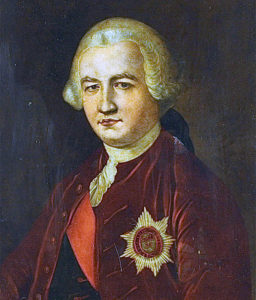
Robert Clive: Battle of Plassey on 23rd June 1757 in the Anglo-French Wars in India: picture by Thomas Gainsborough
Winner of the Battle of Plassey: The army of Robert Clive assisted by traitors in the army of Siraj-ud-Daulah.
Uniforms, arms and equipment at the Battle of Plassey:
The Indian soldiers were armed with bows, swords and spears. There were some firearms, mainly firelocks. Siraj-ud-Daulah’s cavalry was largely recruited from the Afghans and Pathans of the north-west, tough and seasoned soldiers fighting with swords and spears.
The significant component of warfare in India in the 1750s became the disciplined French and British infantry and artillery. There were few of these troops and, while effective in the field against the Indian levies, they were susceptible to disease and quickly became casualties.
The answer for the French and the British to the small number of European troops and their vulnerability to tropical disease was to recruit Indian sepoys, arm them with muskets and train them in European battle drill.
The purpose of the various European nationalities in India was initially to trade and there was a reluctance to become involved in the raising, training and paying of large bodies of troops, until it became clear that this was unavoidable, if a presence was to be maintained in India. The French and British quickly became a major force in Indian warfare, due to their advanced military technology and discipline and their urge to dominate India.
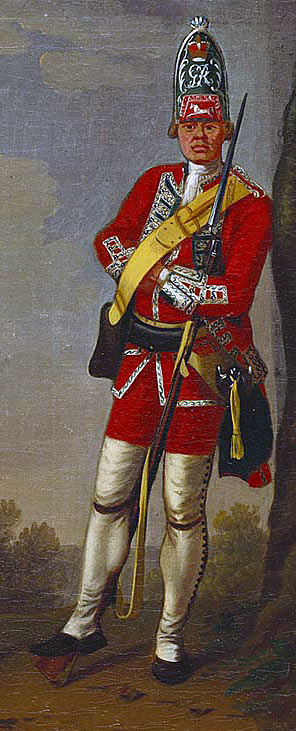
Grenadier HM 39th Foot: Battle of Plassey 23rd June 1757 in the Anglo-French Wars in India: picture by David Morier
Malleson states that the rate of fire for Indian gunners in the 1750s was around 1 shot every fifteen minutes. The European rate of gunfire, 2 or 3 rounds a minute, came as a shock. European cannon had screw mechanisms to adjust the elevation of the barrel, an essential sophistication that was missing from the Indian guns. Malleson states that the battle tactics of Indian commanders tended to be based on the erroneous assumption that once European guns were discharged there was a period of fifteen minutes during which an attack could be launched, while the guns were reloaded. Other features of French and British tactics that came as a surprise were disciplined volley firing and the aggression of European infantry assaults. (In these early days there were no European cavalry or sepoy cavalry in India and the French and English relied on Indian horsemen such as the Mahrattas, although none were present at Plassey)
The combination of these tactical characteristics with the adept and ruthless leadership shown by Robert Clive and other British officers and by some of the French officers, such as M. Paradis, explains how battles were won by small numbers of European troops and sepoys fighting large Indian armies.
Indian armies were feudal levies and the death of a leader was liable to cause his followers to melt away, in part because of a collapse of morale, but also because they no longer considered themselves under an obligation to fight.
Although Britain and France were repeatedly at war in Europe and North America during the 18th Century, in India most of the fighting was against local Indian rulers supported by either the English or the French and not directly between the two rival European powers. In Bengal, the Nawabs were concerned to maintain the presence of the French as a counterbalance to the increasingly ambitious and aggressive English East India Company. The English, on the other hand, were keen to evict all the rival European companies from Bengal, especially the French.
The European troops and sepoys raised by the East India Companies of Britain and France were equipped and armed in the same way as their national infantry.

Clive’s troops in the mango grove at the Battle of Plassey on 23rd June 1757 in the Anglo-French Wars in India
The weapons carried were a musket with bayonet and a small sword, known in the British army as a ‘hanger’. On campaign, each soldier carried around 25 musket rounds, made up in paper cartridges, in a leather pouch hung from a shoulder belt. The uniform was a coat, red for the British and blue for the French, waistcoat and tricorne hat, worn according to the demands of the weather. In some instances, white was worn instead of blue or red. Sepoys wore shorter coats of their employing nation’s colour. The headgear for sepoys was a local variant of the tricorne. European troops wore stockings, gaiters and heavy shoes. Sepoys wore Indian clothing on their lower body, with sandals or bare feet.
Contemporary accounts of the wars refer to ‘European’ troops, rather than British or French. Both British and French East India Companies recruited whatever European soldiers were prepared to join their armies, regardless of nationality. If captured, a European soldier was very likely to enlist with his captor, rather than remain in prison, so that the British forces contained Frenchmen, along with soldiers of many other European nationalities, with a predominance of British. Equally so with the French.
There were so many Frenchmen in Clive’s army at Plassey, that it was a consideration in deciding at Katwa whether to attack or to wait, that Monsieur Law’s French contingent might join Siraj-ud-Daulah’s army, thereby causing Clive’s Frenchmen to desert.
By 1757, the English East India Company Army was reinforced by His Majesty’s 39th Regiment of Foot. The 39th fought at Plassey.

Siraj ud Daulah: Battle of Plassey on 23rd June 1757 in the Anglo-French Wars in India: picture by Richard Caton Woodville
Background to the Battle of Plassey:
Robert Clive’s early successes were in the south east of India, based on the East India Company’s Madras settlement. The other important trading centres for the East India Company were in Bombay, on the west coast of India and, pre-eminently, at Calcutta in Bengal, at the northern end of the Bay of Bengal, in the east of the sub-continent.
The English East India Company was enabled to establish a permanent presence on the Hugli River, on which present day Calcutta stands, in around 1645, with the consent of the local rulers. The purpose of this establishment was to trade with the merchants and manufacturers in the area and to send the goods acquired by sea to England for profit. The settlement was provided with minimal fortifications and defences.
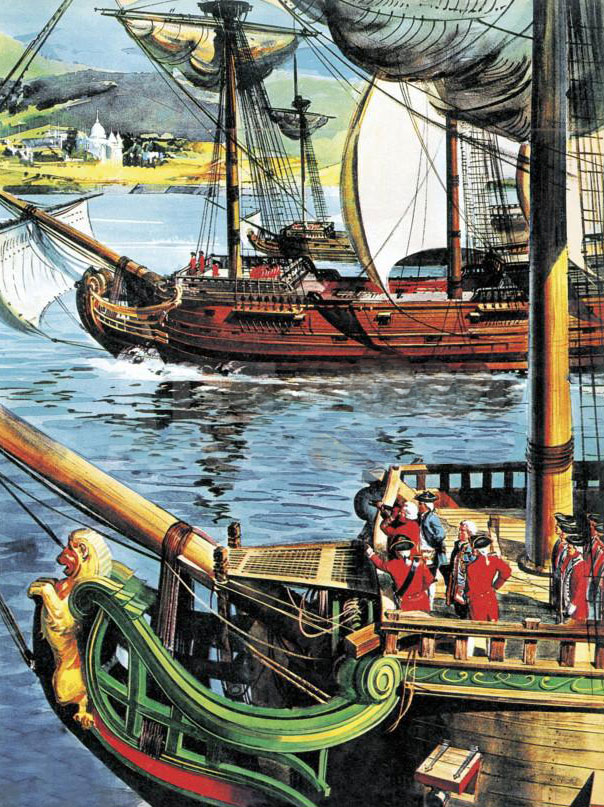
Clive sails up the Bay of Bengal to the Ganges River to recapture Calcutta: Battle of Plassey on 23rd June 1757 in the Anglo-French Wars in India
The East India Company built up an increasing influence in the area. Bengal was subject to repeated invasions by Afghans and Mahrattas from the north and west and the Company’s substantial financial contributions to the defence of the area were important to each Nawab, who ruled Bengal.
In 1689, the East India Company withdrew from the Hugli to Madras, due to the excessive demands of the Nawab of Bengal, Shaista Khan. The following year the Nawab’s successor, Ibrahim Khan, persuaded the company to return. The new settlement was established on the Hugli River, but further south, in a group of villages near the site of Calcutta.
The equivalent French and Dutch companies were already established on sites further up the Hugli River, the French at Chandranagar.
In 1741, Alivardi Khan became Nawab of Bengal, after overthrowing and killing his predecessor, Sarfaraz Khan. The Mughal ruler at Delhi was much weakened by a series of invasions by the Mahrattas and left the magnates in Bengal to sort affairs out among themselves. Alivardi Khan was quickly confirmed in his position.
Alivardi Khan spent the years 1741 to 1756 repelling the repeated invasions of his realms of Bengal, Bihar and Orissa by the Mahrattas, but was eventually forced to come to terms with them.
The foreign traders established along the Hugli were little affected by the wars fought by the Nawab. They probably profited from them as increasing numbers of merchants moved east to escape from the depredations of the Mahrattas.
The East India Company obtained permission to build defensive works around its settlement, which were begun but not finished.
In 1756, Alivardi Khan died and was succeeded by his grandson Siraj-ud-Daulah.
Siraj-ud-Daulah did not share his grandfather’s esteem for the English settlement. He immediately resolved to evict the East India Company from Bengal. On the excuse that they were increasing their fortifications against him and that they were harbouring political offenders, Siraj-ud-Daulah seized the Company’s factory (a storage and trading rather than a manufacturing facility) at Cossimbazar on 4th June 1756. He imprisoned the garrison and appropriated the Company’s property.
On 19th June 1756, Siraj-ud-Daulah with a large army captured Calcutta after a four-day siege (the war with the British became known as the Third Carnatic War and was to lead to British domination of Bengal).
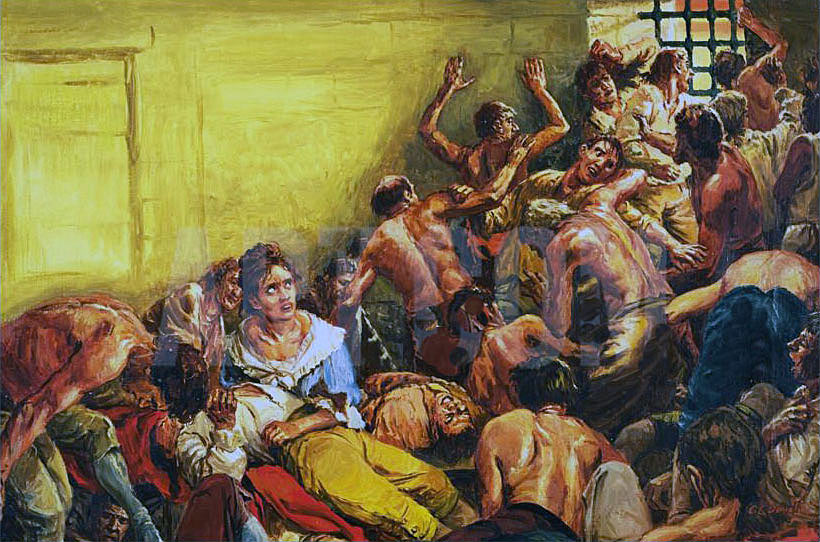
Black Hole of Calcutta: Battle of Plassey on 23rd June 1757 in the Anglo-French Wars in India: picture by Cecil Doughty
The Black Hole of Calcutta:
That night the incident took place, subsequently known as the ‘Black Hole of Calcutta’. Traditionally, it is claimed that 123 of 146 prisoners from the captured British garrison and their families, held in the hole, died during the night, due to the heat and the number of persons in a cell designed for 2 or 3 prisoners. The figure was computed by John Holwell, a survivor, and is disputed. It seems clear that Siraj-ud-Daulah did not directly cause the detention of the prisoners in the cell and that he ordered the release of the survivors the next morning.
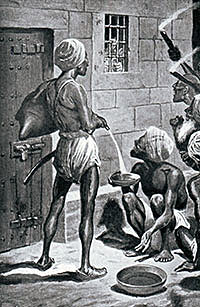
Bribed Indians providing water to the prisoners in the Black Hole: Battle of Plassey on 23rd June 1757 in the Anglo-French Wars in India: picture by Richard Caton Woodville
Many of the garrison escaped from Calcutta on board English ships and sailed down river to Fulta, to await the arrival of a relieving force from Madras.
The Re-capture of Calcutta
News of the loss of Calcutta reached Madras on 15th July 1756 and a force under Major Kilpatrick was dispatched to Fulta, at the mouth of the Hugli in Bengal.
A Royal Navy squadron was present in the Bay of Bengal, commanded by Vice Admiral Watson. The Company authorities at Madras resolved to send as many of the troops and ships at their disposal to retake Calcutta, in spite of the imminence of hostilities with the French, who were present in strength in Southern India.
It took some time to assemble the military force and decide that it was to be commanded by Robert Clive, the fleet being commanded by Admiral Watson. The fleet sailed on 16th October 1756 for the Hugli River.
The ships arrived at Fulta between 11th and 20th December, other than the Marlborough, which arrived at the end of January 1757 and the Cumberland which was forced south and went aground, finally arriving in mid-March 1757.
Once Clive landed in Bengal, Siraj-ud-Daulah’s main force left Calcutta. The small garrison left behind surrendered to Clive on 2nd January 1757. On 9th January 1757 Clive captured the town of Hugli.
After re-occupying Calcutta, Clive disposed of a force of some 900 European soldiers, 1,200 sepoys and around 15 guns.
Siraj-ud-Daulah resolved to attack Calcutta again. For this operation, he raised an army said to have comprised 18,000 cavalry, 25,000 infantry and 40 guns. He marched on Calcutta, arriving at the edge of the Mahratta Ditch, a defensive work giving protection to the settlement, on 3rd February 1757.
On 4th February 1757, Clive attacked Siraj-ud-Daulah’s camp. He intended a night attack, but being delayed, Clive attacked in a thick fog in the early hours of the morning. The fog lifted, revealing Clive’s small force in the middle of the camp. Clive fought his way out, leaving Siraj-ud-Daulah so intimidated by the aggressive assault that he withdrew.
On 9th February 1757, Siraj-ud-Daulah signed a treaty restoring to the Company its former privileges and agreeing to hand over the property looted in the capture of Calcutta and Cossimbazar.
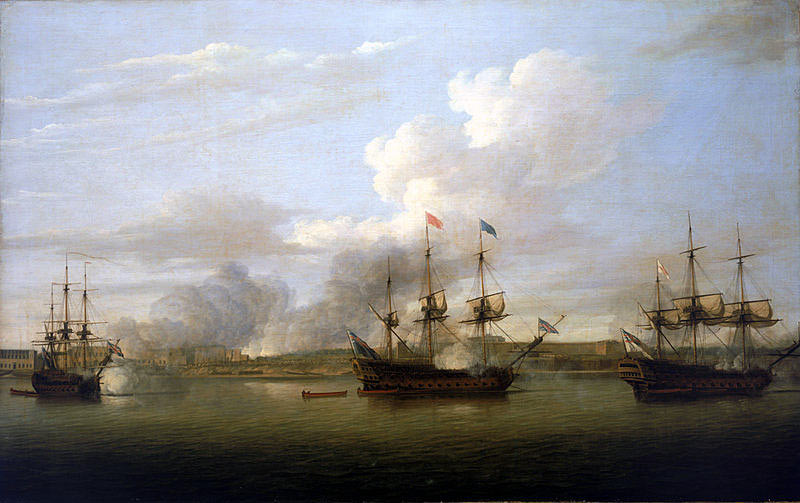
Capture of Chandranagar by Admiral Watson and Robert Clive: Battle of Plassey on 23rd June 1757 in the Anglo-French Wars in India: picture by Dominic Serres
Soon after the signing of the treaty between the East India Company and Siraj-ud-Daulah, news reached the English in India from Europe of the outbreak of war between England and France. This posed a considerable dilemma. Clive was under orders to return to Madras with his army. This would leave Calcutta at the mercy of a combination between Siraj-ud-Daulah and the French. Clive resolved to act decisively before leaving Bengal for Madras.
For Clive, the obvious course was to attack and destroy the French settlement at Chandranagar (now Chandernagore). This would be a provocation to Siraj-ud-Daulah, the Nawab, as all the foreign settlements were under his protection and warfare between them could only be conducted with his permission. Siraj-ud-Daulah needed the French in Bengal as a counter balance to the increasingly aggressive English.
Clive marched on Chandranagar and, after bribing the Nawab’s general sent to intervene, took and destroyed the settlement on 23rd March 1757.
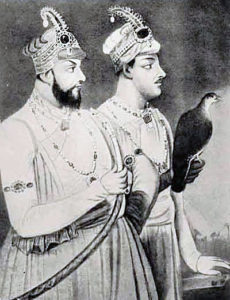
Mir Jafar Khan (left) and his son Mir Miran: Battle of Plassey on 23rd June 1757 in the Anglo-French Wars in India
This action on Clive’s part infuriated Siraj-ud-Daulah. He was just twenty years of age. English descriptions of Siraj-ud-Daulah give him as spoilt and inexperienced, in contrast to his adversary Clive, a highly talented and ruthless soldier and statesman. In addition, Siraj-ud-Daulah’s realm was constantly threatened with invasion on its western border by the Afghans and the Mahrattas, diverting his resources and attention from his problems with the English in the east.
Clive had many years experience of manipulating the Indian leaders against whom he was pitted. From his arrival in Bengal, Clive worked to corrupt Siraj-ud-Daulah’s generals and courtiers. As further war became imminent, with the destruction of Chandranagar, Siraj-ud-Daulah could rely fully on only a small number of his senior commanders, with many of the major interests in his capital, Murshidabad, committed to the English.
The one body of troops that Siraj-ud-Daulah would have been able to rely upon fully, Monsieur Law and his French troops, Siraj-ud-Daulah ordered to move 100 miles to the west, to Bhagalpur.
After the capture of Chandranagar, Siraj-ud-Daulah and the East India Company Committee in Calcutta exchanged a long series of letters of complaint. During the three months of this correspondence, Siraj-ud-Daulah moved his army to Plassey on the Bhagirathi River, 22 miles south of Murshidabad. His army was commanded by Raja Durlabh Ram and contained a large force led by his uncle by marriage, Mir Jafar Khan. Both these generals were proposing to betray Siraj-ud-Daulah.
Clive and the Company Committee in Calcutta chose to take the presence of Siraj-ud-Daulah’s army at Plassey as a direct threat to Calcutta.
During this time, Clive negotiated a treaty, through the intermediary William Watts, with Mir Jafar Khan, whereby the English would assist Mir Jafar Khan in obtaining the Nawabship of Bengal, Bihar and Orissa, in exchange for substantial payments to the Company and its various officers. Many of Siraj-ud-Daulah’s senior officers were in support of Mir Jafar Khan in this conspiracy. Under the treaty Mir Jafar Khan undertook to change sides during any hostilities.
During the standoff between Siraj-ud-Daulah and the Company authorities, a letter arrived in Calcutta from the Mahratta Chieftain at Berar, proposing that he should invade Bengal with an army of 120,000 men and fight Siraj-ud-Daulah in alliance with the English.
Clive suspected, wrongly, that this letter was a forgery, sent on behalf of Siraj-ud-Daulah to establish what the English intentions were towards him. Acting on that assumption, Clive sent the letter to the Nawab. Siraj-ud-Daulah was appalled at the threat of such an invasion and recalled his army to defend Murshidabad.
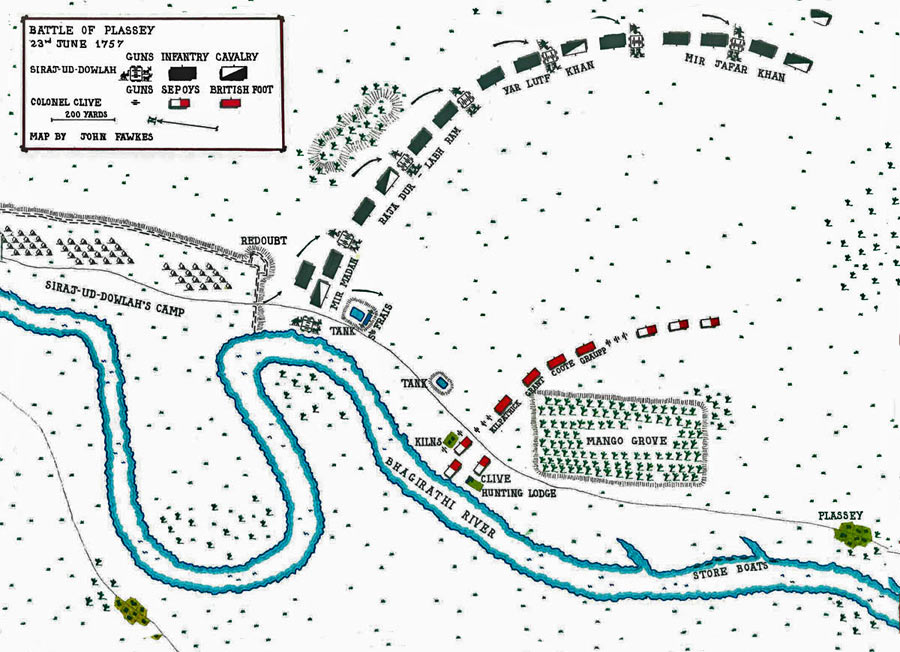
Map of the Battle of Plassey on 23rd June 1757 in the Anglo-French Wars in India: map by John Fawkes
Account of the Battle of Plassey:
On 12th June 1757, the remaining troops at Calcutta, with 150 sailors from Admiral Watson’s squadron, marched to join Clive’s force at Chandranagar. Clive now had 950 European Troops (including 250 men from His Majesty’s 39th Foot), 2,100 sepoys, 100 artillerymen, 60 sailors and eight 6 pounder guns and 2 howitzers.
Clive marched out of Chandranagar on 13th June 1757, leaving a garrison of 100 men. Arriving on 16th June at Palti, Clive sent Major Eyre Coote of the 39th Foot with a small force to take the post of Katwa, containing an Indian garrison and a considerable quantity of supplies. The garrison surrendered to Coote after a token resistance.
As Clive and his army approached Siraj-ud-Daulah’s camp, the correspondence with Mir Jafar Khan became less than satisfactory, leaving Clive to wonder whether Mir Jafar Khan would in fact comply with the obligations set out in the secret treaty and betray Siraj-ud-Daulah. If he did not, the likelihood was that Clive’s army would be overwhelmed in any battle.
Clive halted the advance at Katwa and wrote to the Committee in Calcutta, asking for their advice as to whether to proceed with the advance. This was an unusual show of hesitation in Clive, normally impetuous to the point of rashness. That evening, after writing to the Rajah of Burdwan, asking him to join his army with a thousand horsemen, Clive held a Council of War with all his officers. The question discussed and put to the council for a vote was whether the army should continue to advance or stay at Katwah, until the intentions of the traitors in Siraj-ud-Daulah ‘s camp became clearer.
The majority of the officers were for staying put. Major Eyre Coote, the hotheaded Queen’s officer of the 39th Foot and a minority of the younger officers were for pressing ahead with the attack. Clive voted with those advocating caution. Coote urged that a delay would enable Monsieur Law to join Siraj-ud-Daulah from Bhagalpur with his French troops, known to have been urgently summoned by Siraj-ud-Daulah. The presence of Monsieur Law’s force in the opposing army, in addition to strengthening it significantly, was likely to cause the many Frenchmen serving in the East India Company army to desert to their own side.
On hearing that Clive was halted at Katwah, Siraj-ud-Daulah rushed his force forward to occupy the camp at Plassey, an established post for his army.
After the Council of War, a further letter reached Clive from Mir Jafar Khan, confirming that in the event of battle he would join the English against Siraj-ud-Daulah. Clive immediately changed his mind and the army marched.
At 6am on 22nd June 1757, the army crossed the Bhagirathi River to the east bank, using the accompanying flotilla of boats which carried the supplies. The crossing took most of the day and brought the army within 15 miles of Plassey.
Clive’s army marched again at sunset on 22nd June 1757. It was now raining heavily, the earliest onset of the annual monsoon weather and, in places, the river overflowed its banks, forcing the soldiers to march in water that reached up to their waists.
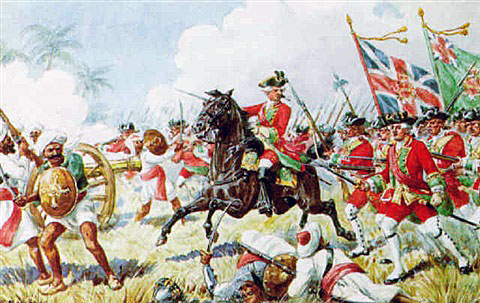
39th Regiment at the Battle of Plassey on 23rd June 1757 in the Anglo-French Wars in India: picture by Richard Simkin
At 1am on 23rd June 1757, the army reached Plassey, a small village with a hunting lodge owned by the Nawab, Siraj-ud-Daulah. The army bivouacked in a mango grove beyond the village, placing vedettes around the grove.
The Company’s troops could hear distant military music. The camp of Siraj-ud-Daulah’s large army was within earshot, about a mile up the river. Clive sent a party to occupy the hunting lodge.
The mango grove, in which the English army encamped, was 800 yards long and 300 yards wide, and contained regular rows of mango trees. Around the grove was a ditch and an embankment.
Siraj-ud-Daulah’s army comprised 35,000 foot soldiers, most poorly armed and lacking formal discipline. His cavalry was around 15,000 horsemen, mostly Pathans from the North-West, well mounted, armed with swords and spears. All skilled and experienced riders.
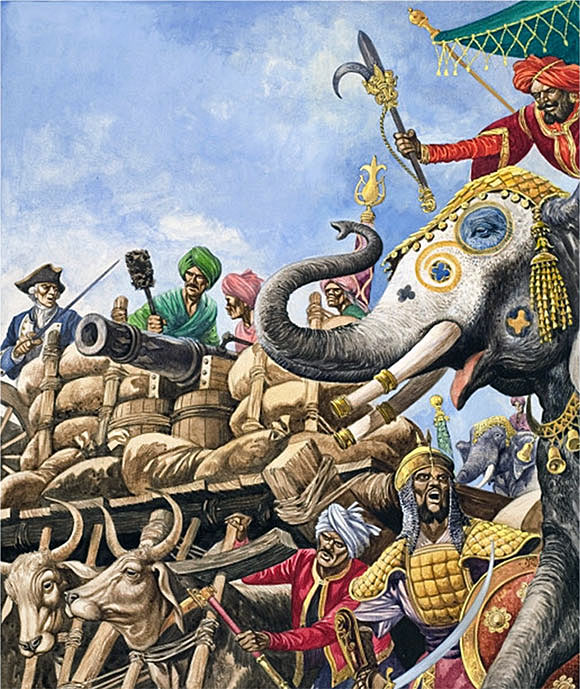
Suraj ud Daulah’s guns advancing at the Battle of Plassey on 23rd June 1757 in the Anglo-French Wars in India: picture by Cecil Doughty
Siraj-ud-Daulah’s artillery comprised 53 cannon, all of heavy calibre; 32, 24 and 18 pounders. Guns of this size, more usually deployed in fixed position siege work, were not ideal for use on the battlefield, being cumbrous, slow to load and difficult to move. The heavy ammunition could not be easily carried with the guns in sufficient quantity for a battle. Siraj-ud-Daulah’s gunners attempted to deal with these various problems by mounting the guns on enormous wooden trucks, towed by oxen and pushed by elephants. The guns were apparently fired from these platforms. It is likely that the rate of fire will have been even slower than on the ground, with each discharge and heavy recoil damaging the wooden structures and terrifying the animals, particularly the elephants, notoriously unreliable in battle and dangerous to their own side.
On the battlefield, a ball from a 32 pounder gun would do little more damage than one from a 6 pounder. Indian gunners were not well drilled and produced a slow rate of fire, taking, according to Malleson, around fifteen minutes to fire each round, as against 2 or 3 rounds a minute for European gunners (this is partly explained by the disparity in the size of the guns that each side deployed).
Locally manufactured, the Indian guns lacked modern refinements such as elevating screws, making it near impossible to aim the guns with any accuracy from the wooden trucks.
In spite of the large number of guns, it seems likely that Siraj-ud-Daulah’s artillery was of little assistance to his army. It seems to have inflicted few casualties on Clive’s army.
The illustration by Richard Caton Woodville, at the head of the site, while giving an idea of how the arrangements for Siraj-ud-Daulah’s cannon may have been made, is incorrect in that the guns shown are of the 6 pounder size.
Supervising the Indian gunners and working a few smaller calibre field guns themselves (see the illustration of a captured French gun) were 40 or 50 Frenchmen, retained from Monsieur Law’s force, all deeply resentful at Clive’s destruction of the French settlement at Chandranagar and commanded by Monsieur St Frais.
Siraj-ud-Daulah’s Plassey camp was covered by entrenched works, stretching for 200 yards away from the river and then for about 3 miles towards the north. At the corner stood a redoubt.
800 yards to the east of the redoubt stood a hillock covered with jungle. Between the two armies and nearer to the mango grove occupied by Clive’s force was a tank or pond and beyond it a larger tank, both surrounded by high mounds of earth.

Assault on the French troops around the Tank at the Battle of Plassey 23rd June 1757 in the Anglo-French Wars in India
At daybreak on 23rd June 1757, Siraj-ud-Daulah’s army marched out of the Plassey encampment and took up battle positions in a rough quarter circle around the English army.
The French troops with 4 cannon occupied the mound around the larger tank, about half a mile from the English army. Between the larger tank and the river were 2 heavy guns manned by Indian gunners. Behind these guns stood Mir Madan Khan, described as Siraj-ud-Daulah’s sole faithful commander, with 5,000 cavalry and 7,000 foot soldiers, all described as the pick of Siraj-ud-Daulah’s army.
The rest of Siraj-ud-Daulah’s army formed in a crescent facing the river, from the jungle covered hillock round to a point behind the mango grove. The commanders were, from the hillock, Raja Durlabh Ram, Yar Lutf Khan, and, on the left, Mir Jafar Khan, the principal traitor. The numbers in this crescent line were 45,000 infantry and cavalry with numerous guns. Clive’s force was effectively surrounded and pinned against the river. His survival and success depended upon the treachery of Mir Jafar Khan and the other Indian commanders.
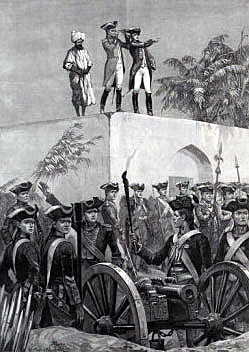
Clive watching Suraj ud Daulah’s deployment from the roof of the hunting lodge: Battle of Plassey on 23rd June 1757 in the Anglo-French Wars in India: picture by Richard Caton Woodville
Clive watched the deployment of Siraj-ud-Daulah’s troops from the roof of the Plassey hunting lodge. As Mir Jafar Khan’s troops extended around the mango grove, outflanking his troops and finally threatening their rear, he must have wondered what would happen if the traitors betrayed him instead of their Nawab.
Contrary to the usual Indian practice of placing artillery together, Siraj-ud-Daulah’s guns were dispersed along his line in twos and threes.
In accordance with his usual tactic of showing a bold front, Clive ordered his troops out of the grove to form a line, with its left resting on the hunting lodge. The European troops were placed in the centre in 4 divisions, commanded by Major Kilpatrick, Major Grant, Major Coote and Captain Gaupp, with 3 of the 6 pounders on each side, and a division of Indian troops on each flank.
Clive sent forward a party with 2 of the 6 pounders and 2 howitzers to occupy a group of brick kilns, 200 yards in front of the left flank.
Both armies were in place by 8am. The French, under St Frais, fired the first gun, which acted as a signal for the opening of a heavy bombardment all along the line of Siraj-ud-Daulah’s army. The Indian line was enveloped in a cloud of powder smoke. The English guns returned the fire and inflicted considerable damage on Siraj-ud-Daulah’s troops.
Clive could not afford even the few casualties caused by the French and Indian gunfire. At the end of half an hour and with 30 casualties Clive pulled his line back behind the mound along the perimeter of the mango grove. The troops and guns posted in the brick kiln and the men in the hunting lodge remained in position.
Encouraged by the English withdrawal, Siraj-ud-Daulah’s guns moved nearer and continued their fire.
Clive’s men were now in cover. They dug embrasures in the mango grove mound for their guns to fire through, while Siraj-ud-Daulah’s cannon caused havoc only among the mango trees, firing over the heads of the English soldiers concealed behind the mound.
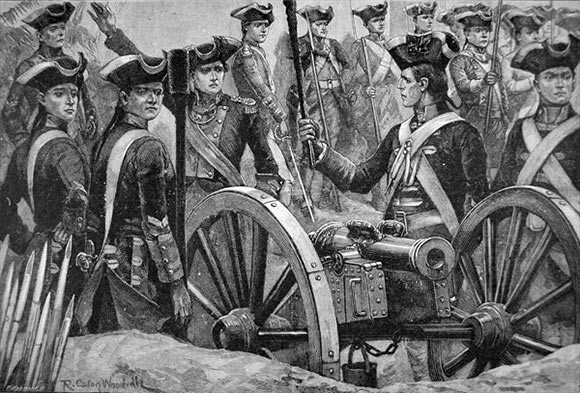
English six pounder gun at the Battle of Plassey on 23rd June 1757 in the Anglo-French Wars in India: picture by Richard Caton Woodville
Clive’s guns resumed their fire with considerable effect, killing Indian gunners and causing supplies of their ammunition to explode, generating panic among the draft animals and clouds of powder smoke.
This cannonade continued for three hours, but without any decisive effect. Siraj-ud-Daulah’s guns maintained their fire and there was no sign of any of his commanders deserting him.
At 11am, Clive called his senior commanders to a council to decide what to do. It was resolved to continue the battle until nightfall and then attack Siraj-ud-Daulah’s camp.
Soon after the council ended a heavy rainstorm came on, continuing for an hour. The English troops were used to campaigning in a country where the monsoon had such an impact. They produced tarpaulins and covered the artillery ammunition to keep it dry. Siraj-ud-Daulah’s artillery did not have tarpaulins and much of their powder was ruined by the rain and rendered unusable. Their fire fell away.
Mir Madan Khan, Siraj-ud-Daulah’s one reliable commander, commanding on the right wing by the river, assumed that the English artillery must have suffered the same catastrophe as his own and launched an attack with his cavalry. They were met with a devastating discharge of grape at short range, which decimated and repelled the charging cavalry and mortally wounded Mir Madan Khan. The dying commander was brought to Siraj-ud-Daulah.
This was the crisis of the battle. While Mir Madan Khan lived and commanded in the key part of the battlefield, it was possible for Siraj-ud-Daulah to win the battle. Without that capable and faithful commander, he was at the mercy of the other three commanders, all disloyal.
Siraj-ud-Daulah sent for Mir Jafar Khan, threw his turban on the ground and begged Mir Jafar to protect him. Mir Jafar promised to defend him to the utmost, then rode back to his wing of the army and sent a letter to Clive informing him of the death of Mir Madan Khan and urging him to attack without delay. This letter did not reach Clive during the battle.
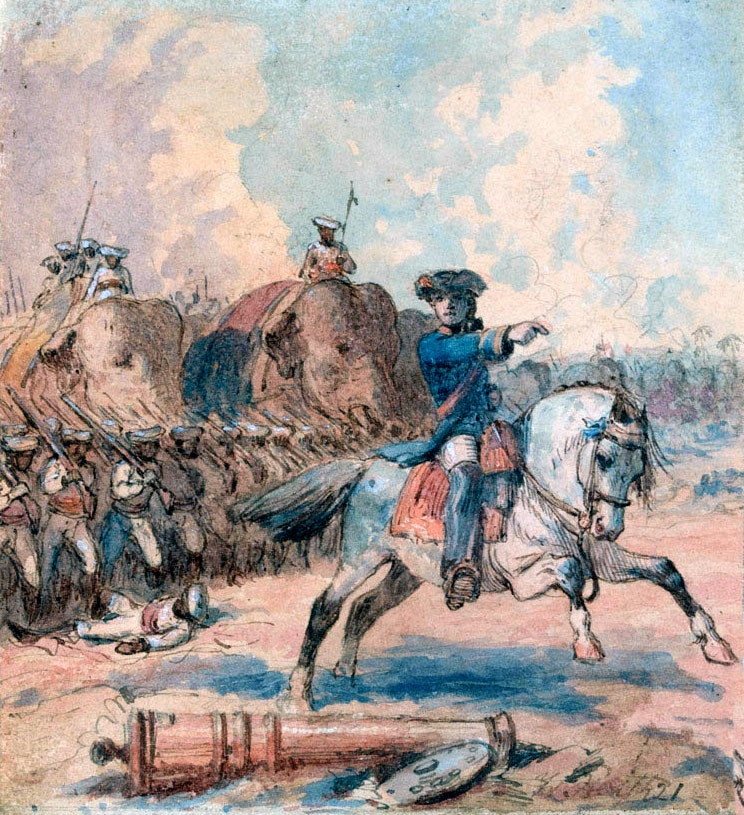
Clive at the Battle of Plassey on 23rd June 1757 in the Anglo-French Wars in India: picture by William Heath
Siraj-ud-Daulah then spoke to his other two commanders. Raja Durlabh Ram urged Siraj-ud-Daulah to order his army to return to the camp and leave the camp himself. Siraj-ud-Daulah adopted this advice and left on a camel for his capital, Murshidabad, with an escort of 2,000 horsemen.
The three treacherous generals began the withdrawal to the camp, the artillery leading the column. They were constrained in their treachery in that their’s was a personal contract with the English, while the rest of the army was generally still faithful to their Nawab, Siraj-ud-Daulah.
In any case, the French commander, St Frais, refused to retreat and continued to fight from the large tank, although the soldiers of the now deceased Mir Madan Khan joined the withdrawal to the camp.
On the English side, once the down pour of rain finished, Clive withdrew into the Plassey Hunting Lodge to put on dry clothes. He left instructions to be told if anything changed in the form of the battle.
On the left of the line, Major Kilpatrick saw the beginning of the withdrawal of Siraj-ud-Daulah’s troops and that the French were being left isolated at the large tank. Kilpatrick took it on himself to order forward his contingent of 250 European troops and 2 of the 6 pounders. He sent an officer to inform Clive of his actions.
Clive’s reaction to the news that Kilpatrick was advancing was fury. He rushed out of the lodge, intending to put Kilpatrick in arrest, but, seeing the general withdrawal of Siraj-ud-Daulah’s army, confirmed Kilpatrick’s decision and ordered the rest of the English line to join the advance.
When Mir Jafar Khan reached the point opposite the western end of the mango grove, his troops left the column and wheeled towards the English positions. Mir Jafar Khan’s intentions were still unclear and Clive was uncertain whether the troops approaching his line were Mir Jafar’s. A small English detachment with a field gun was given the task of halting this approach, which it did.
St Frais, to avoid being overwhelmed, withdrew to the redoubt on the corner of the entrenchments, as the long column of Siraj-ud-Daulah’s army made its way into the camp.
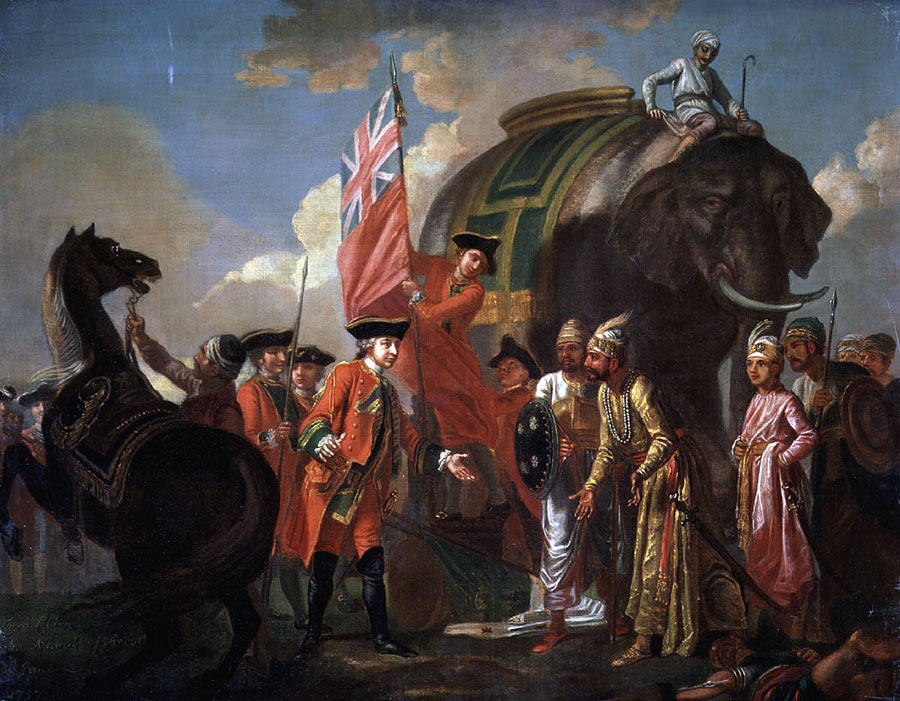
Clive meets Mir Jafar Khan after the Battle of Plassey on 23rd June 1757 in the Anglo-French Wars in India: picture by Francis Hayman
Clive moved his force forward to the tank abandoned by St Frais and began a bombardment of the Plassey camp. The reaction from Siraj-ud-Daulah’s thousands of soldiers who were not part of the conspiracy against him was to turn back, march out of the camp and resume the battle, which now became intense.
Clive moved his force nearer to the camp in three detachments. one, comprising nearly half his force, moved to the mound by the smaller of the two tanks, while the other half advanced to the higher ground between the tank and the river. A further party of some 160 men from the grenadier company of the 39th Foot and a sepoy grenadier company moved even closer, occupying another tank. All the English troops and guns opened a general fire on Siraj-ud-Daulah’s army.
Siraj-ud-Daulah’s soldiers fought hard, but were leaderless and without direction, other than St Frais’ Frenchmen. The cannon and musket fire from Clive’s positions inflicted great loss on Siraj-ud-Daulah’s troops and the oxen towing the platforms for the heavy guns.
It became clear to Clive that the substantial Indian force, motionless but in a position that appeared to threaten his right flank, must be the troops of Mir Jafar Khan. Free from anxiety of an assault by this force, Clive launched attacks on the hill to the left of the French redoubt and, once that was successful, on St Frais’ men in the redoubt itself. Isolated and outnumbered, St Frais retired from the redoubt.
From then on, resistance by Siraj-ud-Daulah’s army ebbed away and, by 5pm, the English were in possession of Siraj-ud-Daulah’s camp and the battle was over.
The pursuit of Siraj-ud-Daulah’s fleeing army was pressed for 6 miles to Dudpore, where it was abandoned with the fall of night.
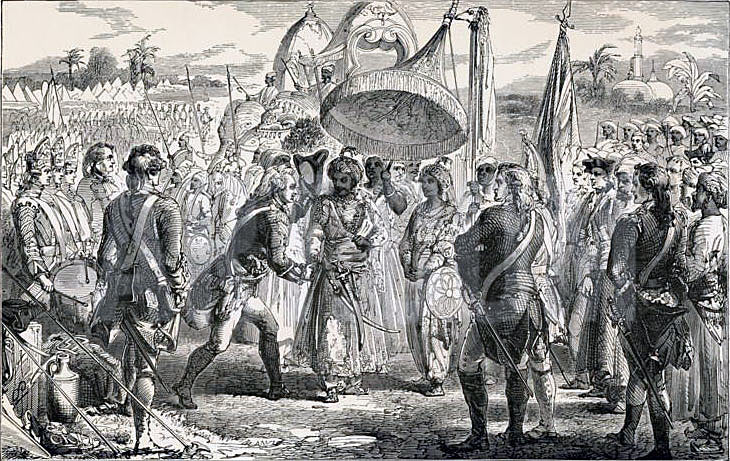
Clive meets Mir Jafar Khan after the Battle of Plassey 23rd June 1757 in the Anglo-French Wars in India: picture by James Godwin
Casualties at the Battle of Plassey:
Clive’s army suffered casualties of 23 dead and 49 wounded. The casualties of Siraj-ud-Daulah’s army were around 500 dead and many wounded. The English captured horses, elephants, and all of the 53 guns brought against it
Battle Honour and Campaign Medal for the Battle of Plassey:
The Battle Honour ‘Plassey’ was awarded to the 39th Foot (later the Dorsetshire Regiment), the 1st Madras Europeans (later the Royal Dublin Fusiliers) and the 1st Bengal Europeans (later the Royal Munster Fusiliers).
No official medal was issued for the Battle of Plassey.
However, the Society for Promoting Arts and Commerce in 1758 issued a medal commemorating the victory at the Battle of Plassey.
Follow-up to the Battle of Plassey:
Following the Battle of Plassey, in accordance with the treaty he had signed with Clive and the East India Company Committee in Calcutta, Mir Jafar Khan entered Murshidabad with Clive and became Nawab of Bengal, Bihar and Orissa. It was however largely an empty honour as the real power in Eastern India was now the English East India Company. Under the treaty, Mir Jafa Khan was compelled to pay substantial sums of money to the East India Company and also to Clive and the Company and Royal officers of his army and the Royal Navy squadron of Vice Admiral Watson that supported the land operations. All these men were enriched by these payments. Those who survived to return to England, Watson and Kilpatrick, and the several others who died soon after Plassey from infectious disease brought on by the oppressive climate became known as ‘Nabobs’ from their India derived wealth.
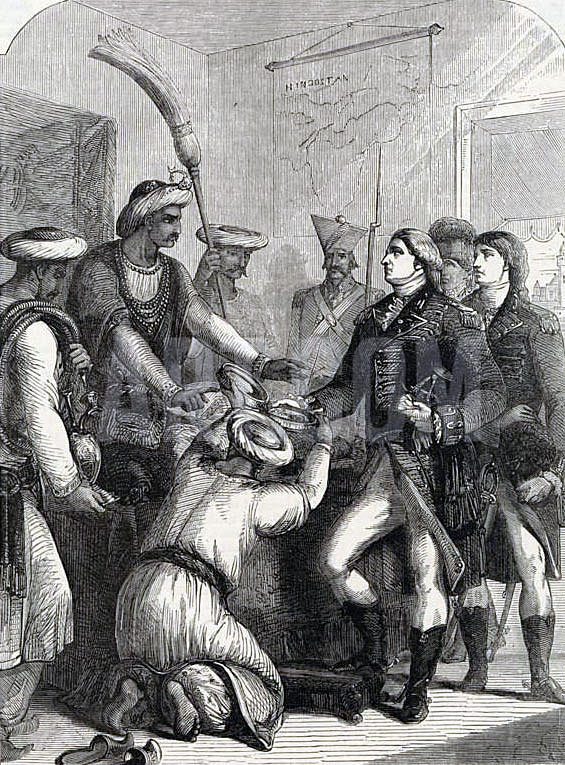
The Great Mogul gives Robert Clive dominion over Bengal, Orissa and Bahar: Battle of Plassey on 23rd June 1757 in the Anglo-French Wars in India
Malleson asserts that the Battle of Plassey set the course for the establishment of the British Empire in India and the Far East.
Siraj-ud-Daulah fell into the hands of the new Nawab, Mir Jafar Khan and was murdered.
Regimental anecdotes and traditions from the Battle of Plassey:
- The ‘Black Hole of Calcutta’ caused a sensation in England, although it does not seem to have been much of an issue among the English in India at the time.
- Siraj-ud-Daulah was known colloquially in England as ‘Sir Roger Dowler’.
- The 39th Foot, from 1880 the Dorsetshire Regiment, adopted the motto ‘Primus in India’, to mark their involvement in the early campaigns as the first Royal Regiment to be sent to India. The motto appeared in the regimental badge.
References for the Battle of Plassey:
- The East India Military Calendar Volume II
- The Decisive Battles in India by Malleson
- History of the British Army by Fortescue Volume II
The previous battle in the Anglo-French Wars in India is the Battle of Kaveripauk
The next battle in the British Battles series is Braddock on the Monongahela
To the Anglo-French War in India index
